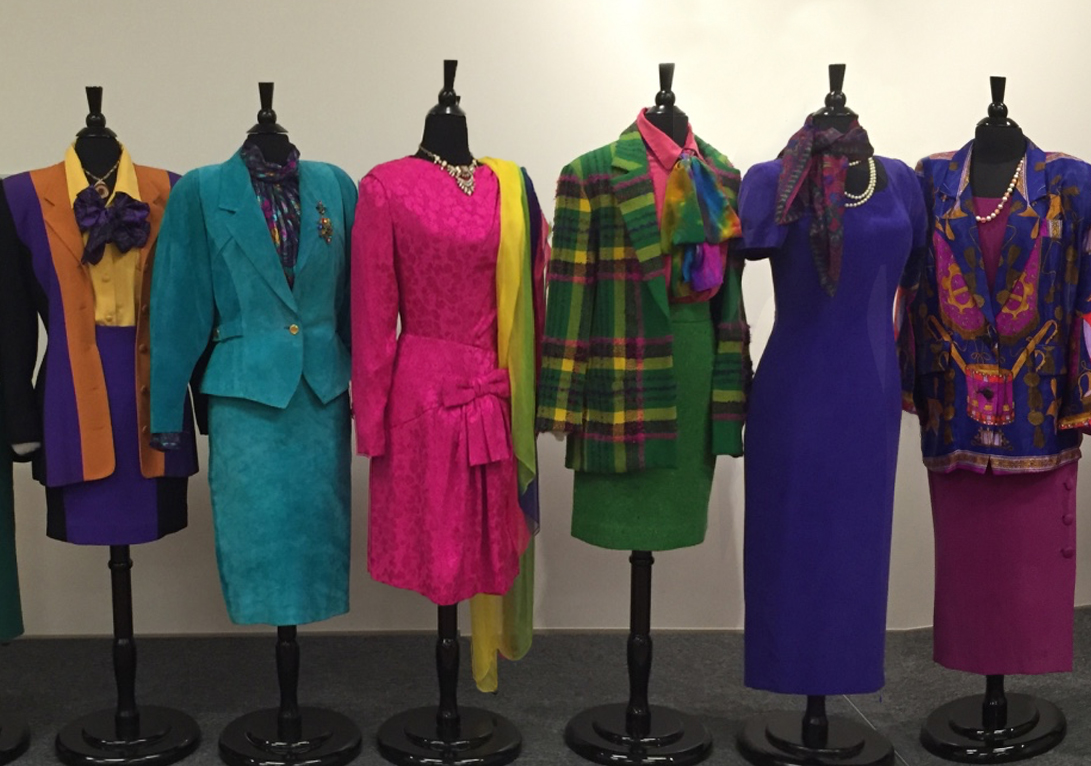
The decade of the 1980s was marked by advances in technology, with the introduction of the personal computer, the expansion of multinational corporations, expanded conflicts in the Middle East, the crisis of AIDS, the fall of the Soviet Union, and a major shift in popular culture with the launch of Music Television (MTV).
It also was highlighted by theatricality in fashion, reflected in the clothing worn by First Lady Nancy Reagan, the colorful pastels of “Miami Vice” detectives Sonny Crockett and Rico Tubbs, the military-style stage costumes of Michael Jackson and Prince, and the snug jeans of Calvin Klein worn by 15-year-old Brooke Shields on advertising billboards. These are all part of “The Eccentrics: The Evolution of the Eighties,” an exhibition of period clothing on display at the Gallery at the Jorgensen Center for the Performing Arts through Oct. 1.
The 70 items in the exhibition are drawn from UConn’s Historical Costume and Textile Collection, an archive of more than 8,000 items that was established to develop and expand the foundations in period studies as well as costume and textile technology dating back to the creation of the University’s Home Economics Department in 1898. “The Eighties” is curated by Laura Crow, professor of costume design in the Department of Dramatic Arts, who has designed for on- and off-Broadway productions and the Connecticut Repertory Theatre, and serves as director of the virtual Historical Costume and Textile Collection Museum.

Crow says the exhibition was inspired by two major acquisitions to the collection, one by designer Erma Duricko, a boutique shopper in New York City during the period, and another by Arnold Scaasi, a designer of gowns for First Ladies Mamie Eisenhower, Barbara Bush, Hillary Clinton, and Laura Bush.
“As a theater designer it appealed to me as the last time we had worn anything theatrical in America,” Crow says. “It was the end of the age of innocence and hope for the future before the Gulf War and terrorism. At the end of the ’80s people started wearing black and neon colors. Spandex was invented and people started wearing black, skimpy clothing. They’ve never really gone back to that expansive, beautiful silhouette of the ’80s. We’ve gone away from all that smashing, beautiful color.”

The multimedia exhibition includes a wide range of clothing displayed around the gallery, video clips from MTV, overhead music from the period, rock star posters, and photographs of celebrities and politicians dressed in formal wear. Among the items are several gowns and dresses designed by Scaasi, pantsuits by Christian Dior, coat dresses by Kenzo and Brooks Brothers, a vintage Levi Strauss denim jacket, and a sheath gown by Maggy of London. Images include musicians Jackson, Prince, Adam Ant, Madonna, Salt N’ Pepa, and Run DMC.
“One of my interests is social anthropology, talking about the life of a person through their clothing,” says Crow. “I think people really relate to the clothes. They have a life of their own. We can envision the person wearing the clothes and feel their presence.”
She says the period was “wonderful” for men’s clothes, noting that Vivian Westwood and Malcolm McLaren started the New Romantics Era of ruffled shirts with big cuffs, exemplified by the attire of Jackson and Prince, who juxtaposed the broad shouldered military style jackets with glitter, glitz, and frills.
The cool stylings of the detectives of “Miami Vice” television show, played by Don Johnson and Philip Michael Thomas, influenced male viewers.
“It corresponded to a time when European designers were first designing unstructured suits and they were made of linen without such heavy tailoring, and were rolling up the sleeve,” Crow says. “Everything was pastels. The producers of the show really wanted to get away from the dark and dreary detective series genre. There were no socks with loafers and suits worn with tee shirts, popularizing other ways to wear a suit beyond a shirt and tie. Later in the series, they tried to move toward the late ’80s fashion with dark colors, and their audience hated it. They moved back to the pastel colors.”

“The Eighties” also displays the contrasting fashions of formal wear created by American designers for Nancy Reagan as she hosted events at the White House, and the images of performers who adopted an androgynous style that crossed gender lines.
“Nancy Reagan made a strong commitment to American designers. She helped them become better known and more productive. The same with Barbara Bush,” Crow says. “The hip hop movement was androgynous. Women started wearing big men’s jackets and old baggy clothes. There was a time when women and men were wearing exactly the same stuff. Then it changed, with women wearing bras underneath those big jackets, and it became sadly more sexist at the end.”
“The Eccentrics: The Evolution of the Eighties” continues in the Jorgensen Gallery, located in the lower level of the Jorgensen Center for the Performing Arts, 2132 Hillside Road, through Oct. 1. The Gallery is open Monday through Friday from 10 a.m. to 4 p.m. For more information go to the Jorgensen Gallery website. The Center is occasionally closed this summer due to construction. Visitors are advised to call ahead to confirm that the Gallery is open: 860-486-4226.



